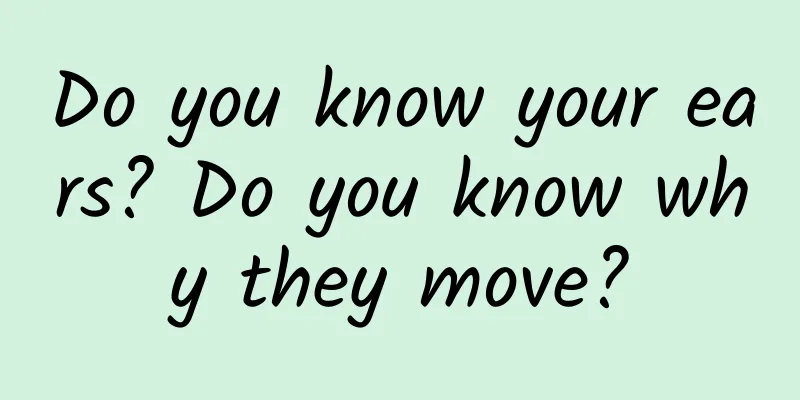Do you know your ears? Do you know why they move?

|
Ears: The magical window through which we perceive the world The ear, this seemingly ordinary but magical organ, is an important window for us to perceive the world. Today, let us walk into the world of the ear and explore its exquisite structure and function. The human ear is composed of three parts: the outer ear, the middle ear and the inner ear. Each part carries a unique function, and together they allow us to perceive and distinguish sounds from all directions. First, let's look at the outer ear. The outer ear is mainly composed of the auricle and the ear canal. The auricle is a protrusion on our head that collects and directs sound into the ear canal. The ear canal is a narrow passage leading to the middle ear. Its curved structure helps reduce interference from external noise and protects our auditory system. Next, the middle ear. The middle ear includes structures such as the eardrum, ossicular chain, and Eustachian tube. The eardrum is a thin membrane that vibrates when sound waves arrive and transmits the sound to the ossicular chain. The ossicular chain is composed of three small bones that transmit the sound to the inner ear using the principle of a lever. The Eustachian tube connects the middle ear and the pharynx, and is responsible for regulating the air pressure in the middle ear and maintaining the normal vibration of the eardrum. Let's go to the inner ear. The inner ear includes the cochlea, vestibule and semicircular canals. The cochlea is a spiral structure filled with fluid and hair cells. When sound is transmitted to the cochlea, the hair cells are stimulated and generate nerve impulses, which are then transmitted to the brain for analysis, allowing us to perceive the pitch, strength and timbre of the sound. The vestibule and semicircular canals are mainly responsible for balance perception, helping us maintain our body balance. The structure and function of the ear are very complex and delicate. From the outside to the inside, each part plays an indispensable role and together they support our hearing and balance perception. By understanding the structure of the ear, we can not only better understand ourselves, but also better cherish and protect this amazing organ. Recently, I often hear people discussing why some people's ears move. This question actually involves multiple fields of human anatomy, genetics and neurobiology. Our ears, as the main organ of hearing, not only capture sound, locate and identify sound, but also have a more mysterious "veil". First of all, we need to understand that not everyone can move their ears. This ability is relatively rare in the population, which is mainly attributed to genetic factors. People who can move their ears have a different ear muscle structure than others and have more developed ear muscles, which allows them to move their ears through neural control. Secondly, from a neurobiological perspective, the movement of the ear depends on the control of the nervous system. When a certain area of the brain issues a command, the nerve signal is transmitted to the ear muscles, causing the ear to move. This control process requires close coordination between the brain, nerves, and ear muscles. Any error in any link may cause the ear to be unable to move. However, although the ability to move the ears is influenced to some extent by genetics and neural control, we should also see that this is not a necessary survival skill, and even to some extent, it may just be an insignificant physiological feature. Nevertheless, for people with this ability, they may show their uniqueness in certain specific occasions, such as performances and imitations. In general, some people's ears move, which is the result of genetics and neural control, and also a reflection of the diversity and wonder of the human body. Understanding this can not only help us better understand the structure and working principle of the human body, but also make us more respectful and appreciative of the uniqueness and wonder of every life. |
<<: Why do wealth bags appear?
>>: What causes tinnitus? How to prevent it
Recommend
What are the symptoms of menstrual disorders?
Many women experience delayed or early menstruati...
Thin endometrium caused by abortion
Abortion is a common method of terminating pregna...
How to induce menstruation after taking birth control pills
Everyone knows that after women take contraceptiv...
Can I eat chocolate during my menstrual period?
There are two temptations that most women cannot ...
Is constipation severe in early pregnancy? Teach you eight easy solutions
In the early stages of pregnancy, the uterus has ...
What is the treatment for endometrial hyperplasia?
The female uterus is relatively fragile and can e...
I went to the hospital to check for coronary heart disease, but the doctor asked me to get on a "treadmill". Why?
Mr. Zhang is in his 50s and has been smoking for ...
Why does a woman feel uncomfortable when she has too much fluid?
When men and women have sex, before they actually...
Why do many people in the Romance of the Three Kingdoms call Liu Bei "Shijun"? What are the main events?
The Romance of the Three Kingdoms can be roughly ...
Why do women feel stinging pain after urinating?
Women are more susceptible to germs, which is rel...
What color is uterine bleeding?
Abnormal uterine bleeding unrelated to menstruati...
What is the best age to get pregnant?
Many female friends often ignore their best child...
What to do if pregnant women have uterine prolapse
The body of a pregnant woman always needs more at...
Why does my menstrual period end in one day?
Nowadays, having a normal menstrual period can be...









